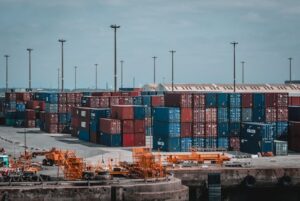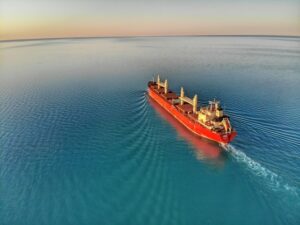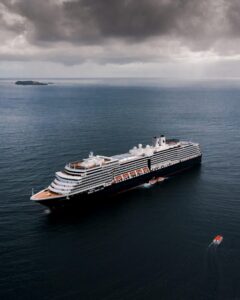INTRODUCTION
One of the most prominent effects of global warming in the 21st century is the rapid melting of glaciers in the Arctic region. Historically, the Arctic Ocean was largely inaccessible for economic and military activities due to being covered by thick ice for most of the year. However, since the 2000s, the retreat of the ice cover has significantly increased the region’s strategic and economic importance.
This development is not merely an environmental phenomenon but also represents a critical turning point in legal and geopolitical terms. The accessibility of the Arctic Route necessitates a reinterpretation of the maritime jurisdiction concepts under the United Nations Convention on the Law of the Sea (“UNCLOS” or the “Convention”). Coastal states increasingly make overlapping claims to extend their continental shelf boundaries and access hydrocarbon resources, directly impacting international law and geopolitical balances.
This article examines maritime disputes, continental shelf claims, and environmental obligations from a legal perspective in the context of the opening of the Arctic Route.
A. THE ARCTIC ROUTE AND STRATEGIC IMPORTANCE
The Arctic Route primarily consists of two passages: the Northern Sea Route (“NSR”) and the Northwest Passage (“NWP”). The NSR follows Russia’s northern coast, reducing the maritime distance between Europe and Asia by approximately 40% compared to the Suez Canal. The NWP connects the Atlantic and Pacific Oceans through the Canadian Archipelago.
The opening of these routes marks a new era not only for maritime transport but also for energy security and military strategy. According to the United States Geological Survey (“USGS”), the Arctic contains approximately 90 billion barrels of oil, 47 trillion cubic meters of natural gas, and 44 billion barrels of liquid natural gas reserves, most of which are located in offshore areas, making the region a strategic center for global energy security.
National strategic documents clearly highlight the Arctic’s geopolitical significance. Russia, in its 2008 and 2013 strategy documents, defines the Arctic as a “core area of national interests,” while the U.S. and Canada, through the 2009 Arctic Policy Directive, outline energy security and national security priorities in the region. This demonstrates that the Arctic is becoming increasingly militarized, intensifying international competition.
B. SCIENTIFIC AND LEGAL LIMITS OF THE CONTINENTAL SHELF AS A NATURAL EXTENSION
UNCLOS grants coastal states rights to explore and exploit the seabed and subsoil of their continental shelf, which constitutes the natural prolongation of their land territory. Article 77 of UNCLOS includes exclusive rights to seabed and subsoil resources, ensuring states’ entitlements under international law.
UNCLOS clarifies the definition and delimitation of the continental shelf, addressing shortcomings in the 1958 Geneva Conventions regarding maritime disputes. Under Article 76(1), “the continental shelf of a coastal state comprises the seabed and subsoil of the submarine areas that extend beyond its territorial sea throughout the natural prolongation of its land territory to the outer edge of the continental margin, or to a distance of 200 nautical miles from the baselines from which the breadth of the territorial sea is measured where the outer edge does not extend up to that distance.” This definition prioritizes the length criterion over depth, adopting the concept of “natural prolongation” as the basis for the continental shelf.
UNCLOS also considers varying geographic conditions in delimiting the continental shelf. States with continental shelves less than 200 nautical miles may extend the seabed up to 200 miles, whereas states with wider continental shelves are limited to a maximum of 350 miles from the baseline; beyond this distance lies the high seas.
Coastal states are expected to negotiate with adjacent or opposite states in good faith and in accordance with international law when determining continental shelf boundaries. If an agreement cannot be reached, Article 83 of UNCLOS provides that delimitation is conducted based on the principles of natural prolongation and equidistance. One major source of disputes in continental shelf delimitation is the status of islands near the coast. Under Article 121 of the Convention, islands with permanent habitation and economic life are entitled to continental shelf rights similar to other land territories.
In the legal process, the Commission on the Limits of the Continental Shelf (“CLCS”) reviews scientific data submitted by states to recommend outer limits of the continental shelf and contributes to resolving disputes under international law. Although CLCS recommendations are scientifically grounded, ultimate legal authority rests with international courts or inter-state negotiations. In geologically complex regions like the Arctic, overlapping claims increase the importance of scientific verification and legal coordination.
Specifically in the Arctic, climate change and retreating glaciers render the concept of the continental shelf’s natural prolongation more relevant. Melting ice opens new maritime routes and access to seabed resources, making the exercise of coastal states’ rights over the natural prolongation and continental shelf critical. States, within the framework of national regulations and international law, exercise rights to explore and exploit Arctic seabed resources in accordance with CLCS procedures under UNCLOS.
UNCLOS does not grant sovereignty over the continental shelf but provides exclusive rights to explore and exploit resources. Coastal states may also take reasonable measures and construct artificial islands, installations, and structures, thereby regulating resource use in international law.
In conclusion, the concept of the continental shelf as a natural prolongation should be approached within a framework supported by scientific evidence and legal mechanisms provided by UNCLOS. Protecting coastal states’ rights, minimizing legal uncertainties in delimitation, and preventing interstate disputes are crucial for the equitable and sustainable use of marine resources. In the Arctic, climate change and ice retreat highlight the dynamic and contemporary dimensions of the continental shelf concept.
C. LEGAL STATUS OF CLCS DECISIONS
Established under Article 76 of UNCLOS, the CLCS examines continental shelf claims beyond 200 nautical miles from baselines and issues recommendations based on scientific and technical evaluation. The Commission consists of experts in geology, geophysics, and hydrography, and its recommendations are advisory in nature.
However, the non-binding nature of CLCS recommendations creates a significant legal gap in international maritime law. Under Article 76(8), only limits established in accordance with the Commission’s recommendations are considered definitive and binding. Limits set unilaterally by a state contrary to CLCS recommendations lack legal validity internationally.
This situation is particularly problematic in the Arctic, where overlapping seabed claims by Russia, Canada, and Denmark remain unresolved due to the non-binding nature of CLCS decisions. States often reinforce claims through de facto control, undermining uniformity and predictability in international law and complicating peaceful dispute resolution.
Consequently, strengthening the legal effect of CLCS recommendations and developing international oversight mechanisms are essential for stability in maritime law.
D. INTERNATIONAL STRAIT STATUS AND THE LEGAL NATURE OF THE NORTHWEST PASSAGE
A contentious legal issue in the Arctic is the applicability of transit passage rights under international straits to the Northwest Passage and the Northern Sea Route. The NWP, stretching through the Canadian Arctic Archipelago, connects the Atlantic and Pacific Oceans, while the NSR follows the Russian northern coast, both potentially shortening maritime routes between Europe and Asia. Due to dense ice and harsh weather, these passages remain hazardous.
Canada and Russia claim these routes as internal waters, requiring permission for foreign vessels. Canada asserts the NWP as internal waters based on straight baselines established in 1985 and historical use by the Inuit. Russia similarly regards parts of the NSR as internal waters.
The United States, however, maintains that both routes are international straits, ensuring transit passage rights. This view is supported by the ICJ’s Corfu Channel case, which recognizes that straits connecting two open seas and suitable for navigation are considered international. Ice retreat has increased vessel traffic in the NWP, rendering it an increasingly useful route for international navigation.
Parties agree on resolving disputes within the UNCLOS framework but differ in interpretation, highlighting the delicate balance between sovereignty and freedom of navigation in maritime law.
E. RUSSIA’S PRIOR PERMISSION REQUIREMENT AND FREEDOM OF THE SEAS
Russia imposes prior permission and pilotage requirements for foreign vessels navigating the NSR, justified by environmental protection and traffic control. However, this limits the freedom of the seas guaranteed under UNCLOS.
Article 87 of UNCLOS stipulates that the high seas and international navigation routes are open for all states for innocent passage. Prior permission and pilotage obligations restrict this right, creating tension between coastal state security and fundamental principles of international maritime law.
F. ENVIRONMENTAL DUTY OF CARE AND CLIMATE-RELATED LIABILITY
Climate change and rapid ice melt in the Arctic increase maritime and economic activity, particularly along the NSR. This raises not only sovereignty issues but also transboundary environmental impacts. Expanding technological activities, especially oil and gas extraction and large-scale shipping, amplify environmental risks, necessitating heightened state duty of care.
States must ensure that their activities do not cause oil spills, maritime accidents, or climate-related harm; otherwise, liability arises under international environmental law and strict liability principles. Emerging Arctic maritime disputes revolve around continental shelf boundaries, navigation rights, and transboundary environmental impacts. States are obliged to act in accordance with UNCLOS Articles 192–201, emphasizing international cooperation, emergency response planning, scientific research, and data sharing.
G. MANDATORY DISPUTE RESOLUTION IN THE ARCTIC
Under Article 287 of UNCLOS, disputes over maritime jurisdiction in the Arctic may be resolved through mandatory procedures, including the International Court of Justice (“ICJ”), the International Tribunal for the Law of the Sea (“ITLOS”), or arbitral tribunals under Annex VII.
Nevertheless, states often prefer diplomatic and bilateral negotiations, including friendly consultations, mediation, conciliation, investigation, and fact-finding, as peaceful dispute resolution methods under UNCLOS and Article 33 of the UN Charter.
Mandatory dispute resolution is critical for upholding the rule of law and overseeing sovereign claims in the Arctic, especially when conflicting claims over the NSR or continental shelf exist. The ICJ, ITLOS, or arbitration mechanisms ensure equitable and peaceful resolution.
H. THE ARCTIC SUNRISE CASE AND STATE IMMUNITY
The Arctic Sunrise case involved the detention of a Dutch-flagged vessel by Russian authorities in the Arctic and was adjudicated by the ICJ. The decision established that state sovereign immunity is not absolute. States cannot evade liability under international law for environmental damage caused in international waters or another state’s jurisdiction. State immunity claims do not provide unlimited protection in cases of environmental violations.
I. CONCLUSION AND ASSESSMENT
Climate change in the Arctic in the 21st century has triggered strategic and legal transformations, directly affecting international maritime law. The melting of ice and emergence of the Arctic Route compel coastal states to reassess continental shelf claims, energy and shipping security, and environmental responsibilities.
Natural prolongation-based delimitation, the non-binding nature of CLCS recommendations, and overlapping claims complicate dispute resolution in the Arctic. Debates over transit passage in the NWP and NSR illustrate the delicate balance between sovereignty and freedom of navigation.
Increasing economic activity and maritime traffic highlight states’ duty of care and liability for climate-induced harm. International law not only governs sovereignty claims but also their environmental and transboundary effects, ensuring sustainable and peaceful use.
Effective and equitable resolution of new Arctic maritime disputes requires international cooperation, science-based delimitation, and robust dispute resolution mechanisms. The future of the Arctic will be shaped by the rule of law, environmental sustainability, and multilateral coordination; otherwise, the region may remain prone to geopolitical competition and legal uncertainty.
REFERENCES
- Basaran, H. (2015). The Lomonosov Ridge Dispute and International Law.
- Kanat, S., Kılınç, S., & Gürkaynak, M. (2022). International disputes in the Arctic region and the impact of global warming. Eskişehir Osmangazi University Journal of Economics and Administrative Sciences, 17(3), 837–861. https://doi.org/10.17153/oguiibf.1144859
- Yıldız, B., & Çelik, M. (2019). Energy policies and geopolitical competition in the Arctic. Journal of International Relations, 16(63).
- Singil, N. (2020). The role of proportionality in continental shelf delimitation.
- Tepealtı, F. (2022). Continental shelf: An assessment in the context of theory and practice. International Journal of Geography and Geography Education (IGGE), 45, 174–196. https://doi.org/10.32003/igge.1014953
- Akbulak, Y. (2024, January 29). On the Continental Shelf and the Capture of Pacific Common Areas. LEGAL Blog. https://legal.com.tr/blog/ekonomi/kita-sahanligi-ve-sessiz-okyanus-ortak-alanlarinin-ele-gecirilmesi-uzerine/
- Yavan, S. (2025). Evaluating the Arctic region’s geopolitical-economic significance from the perspective of global climate change. Academic Research and Studies Journal, 17(32), 359–377. https://doi.org/10.20990/kilisiibfakademik.1621714
- Tutak, E. (2022). Determining the most effective recourse for maritime disputes in international law using fuzzy AHP approach. Paradigma: Journal of Economic and Administrative Research, 11(1), 1–20. https://doi.org/10.46763/piaad.2022110101











